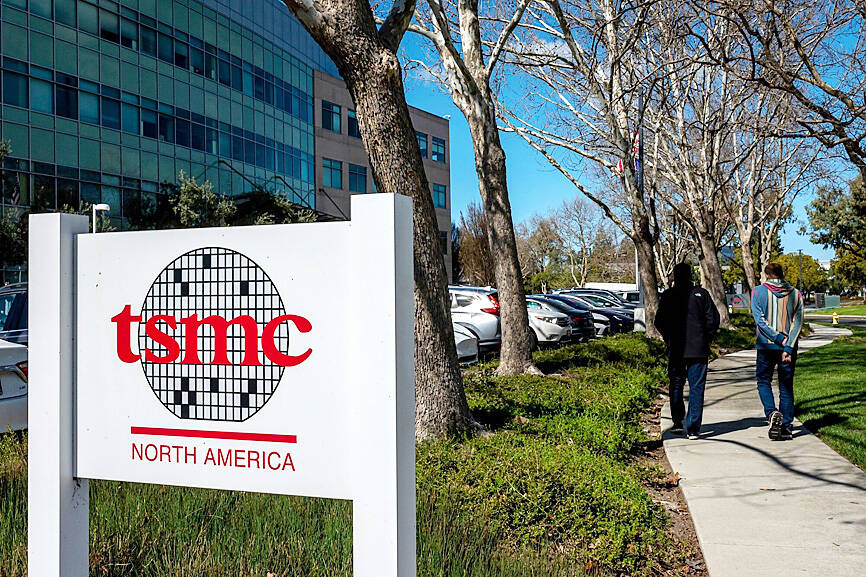Taiwan Semiconductor Manufacturing Co (TSMC, 台積電) retained its top position in the global wafer foundry business in the fourth quarter of last year and widened its lead over second-placed Samsung Electronics Co, TrendForce Corp (集邦科技) said in a report on Monday.
TSMC posted US$26.85 billion in sales in the October-to-December period, up 14.1 percent from the previous quarter, which lifted its market share to 67.1 percent, up from 64.7 percent in the prior quarter, the Taipei-based market researcher said.
In contrast, Samsung’s sales fell 1.4 percent sequentially to US$3.26 billion last quarter and its market share slid to 8.1 percent from 9.1 percent over the period, the report said.

Photo: Bloomberg
That widened the gap between the two companies to 59 percentage points last quarter from 55.6 percentage points a quarter earlier.
TrendForce attributed TSMC’s growth to persistent demand for artificial intelligence (AI)-related chips and advanced packaging services, in addition to steady orders for chips used in high-end smartphones and new PC platforms.
Meanwhile, Samsung’s revenue fell as order gains from new clients for advanced-node chips did not fully offset declines in orders from major existing clients due to rising competition in mature nodes from Chinese rivals, the report said.
China’s Semiconductor Manufacturing International Corp (中芯) came in third with US$2.21 billion in revenue last quarter and a market share of 5.5 percent, narrowing its gap with Samsung to 2.6 percentage points from 3.1 percentage points in the previous quarter, the report said.
United Microelectronics Corp (聯電) ranked fourth with US$1.87 billion in revenue and a 4.7 percent market share, ahead of US-based GlobalFoundries Inc with US$1.83 billion in revenue and a 4.6 percent market share, the report showed.
In sixth to 10th places were China’s Huahong Group (華虹) with US$1.04 billion in revenue and a 2.6 percent market share; Israel’s Tower Semiconductor Ltd with US$387 million and 1 percent market share; Vanguard International Semiconductor Corp (世界先進) with US$357 million and 0.9 percent; China’s NexChip Co (晶合集成) with US$344 million and 0.9 percent; and Powerchip Semiconductor Manufacturing Corp (力積電) with US$333 million and 0.8 percent, the report added.
The combined revenue of the top 10 wafer foundry companies reached a fresh record high of US$38.48 billion last quarter, up 9.9 percent from US$35.01 billion in the previous quarter, as strong demand for advanced-node chips for AI servers, flagship smartphone application processors and new PC platforms helped offset the slowdown in demand for mature-node chips, TrendForce said.
As the industry’s momentum remains largely unchanged, overall foundry revenue this quarter is forecast to decline slightly from last quarter, despite the beginning of a year being a seasonally weak quarter for foundries, TrendForce added.

UNCERTAINTY: Innolux activated a stringent supply chain management mechanism, as it did during the COVID-19 pandemic, to ensure optimal inventory levels for customers Flat-panel display makers AUO Corp (友達) and Innolux Corp (群創) yesterday said that about 12 to 20 percent of their display business is at risk of potential US tariffs and that they would relocate production or shipment destinations to mitigate the levies’ effects. US tariffs would have a direct impact of US$200 million on AUO’s revenue, company chairman Paul Peng (彭雙浪) told reporters on the sidelines of the Touch Taiwan trade show in Taipei yesterday. That would make up about 12 percent of the company’s overall revenue. To cope with the tariff uncertainty, AUO plans to allocate its production to manufacturing facilities in

Taiwan will prioritize the development of silicon photonics by taking advantage of its strength in the semiconductor industry to build another shield to protect the local economy, National Development Council (NDC) Minister Paul Liu (劉鏡清) said yesterday. Speaking at a meeting of the legislature’s Economics Committee, Liu said Taiwan already has the artificial intelligence (AI) industry as a shield, after the semiconductor industry, to safeguard the country, and is looking at new unique fields to build more economic shields. While Taiwan will further strengthen its existing shields, over the longer term, the country is determined to focus on such potential segments as

TAKING STOCK: A Taiwanese cookware firm in Vietnam urged customers to assess inventory or place orders early so shipments can reach the US while tariffs are paused Taiwanese businesses in Vietnam are exploring alternatives after the White House imposed a 46 percent import duty on Vietnamese goods, following US President Donald Trump’s announcement of “reciprocal” tariffs on the US’ trading partners. Lo Shih-liang (羅世良), chairman of Brico Industry Co (裕茂工業), a Taiwanese company that manufactures cast iron cookware and stove components in Vietnam, said that more than 40 percent of his business was tied to the US market, describing the constant US policy shifts as an emotional roller coaster. “I work during the day and stay up all night watching the news. I’ve been following US news until 3am

COLLABORATION: Given Taiwan’s key position in global supply chains, the US firm is discussing strategies with local partners and clients to deal with global uncertainties Advanced Micro Devices Inc (AMD) yesterday said it is meeting with local ecosystem partners, including Taiwan Semiconductor Manufacturing Co (TSMC, 台積電), to discuss strategies, including long-term manufacturing, to navigate uncertainties such as US tariffs, as Taiwan occupies an important position in global supply chains. AMD chief executive officer Lisa Su (蘇姿丰) told reporters that Taiwan is an important part of the chip designer’s ecosystem and she is discussing with partners and customers in Taiwan to forge strong collaborations on different areas during this critical period. AMD has just become the first artificial-intelligence (AI) server chip customer of TSMC to utilize its advanced